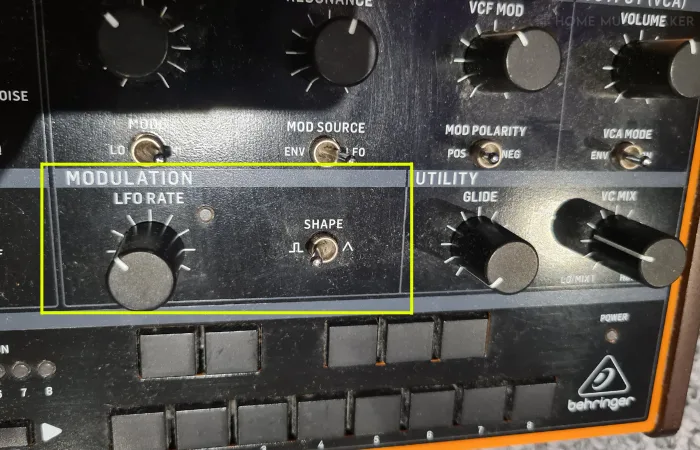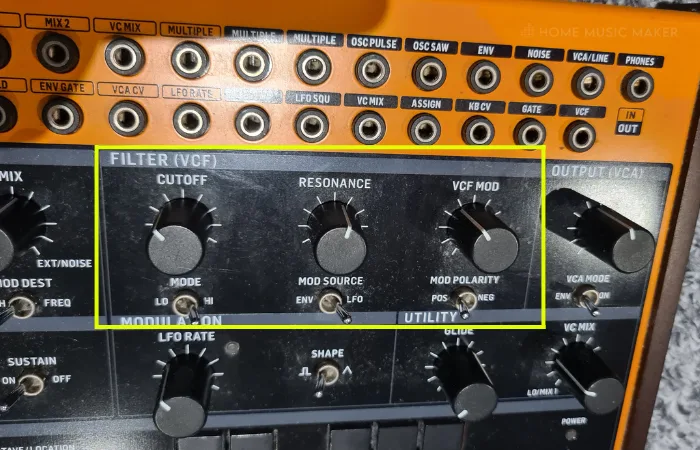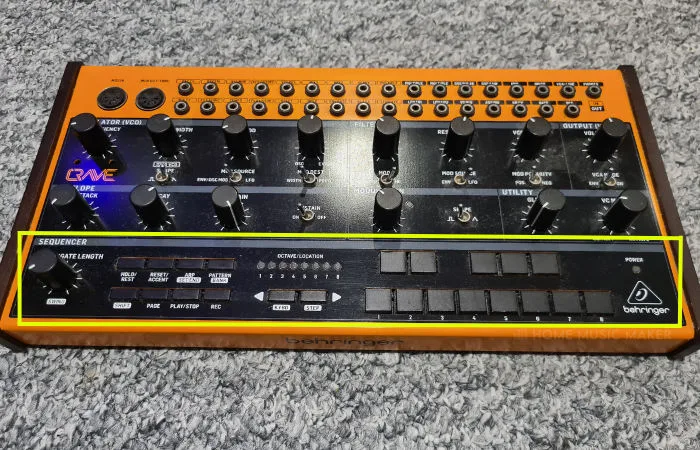KEY TAKEAWAYS:
Behringer Crave is an affordable semi-modular analog synth. It features two oscillators, LFO, an envelope generator, a low-pass filter, a sequencer, and intuitive controls. There’s also a patch bay for creative modulation possibilities. It’s portable and great for beginners and experienced synth enthusiasts. It produces impressive smooth and creamy sounds for atmospheric sounds and lush pads.
Behringer Crave
Unleash your inner audio architect with the Behringer Crave, an affordable semi-modular analog synth that packs a punch!
Boasting classic subtractive synthesis and experimental sound design capabilities, this compact beast is equipped with a 3340 VCO, a 24 dB ladder filter, and a versatile sequencer to deliver rich, warm, and gritty sounds. Priced at under $200, the Crave is a must-have for both seasoned synth enthusiasts and newcomers alike.
Dive into this article and discover why this intuitive and budget-friendly synth should be on your radar.
Features
If you’re looking for an affordable, semi-modular analog synth, the Behringer Crave is a great option. It offers a lot of sound-shaping possibilities. It’s a great choice regardless of your skill level and experience with synths.

Here are some of its key features:
Oscillators
The Behringer Crave has two analog oscillators. You can have a sawtooth, square, or triangle wave.
The second oscillator is actually in the modulation section of the synth. To use it as an audible oscillator, you must use the patch bay to re-route it.
You can adjust the frequency, pulse width, and pitch of each oscillator. This gives you lots of flexibility in shaping your sound.
The Behringer Crave is monophonic, meaning that even though you can play both oscillators, you can only play one note at a time.
Pro Tip
To record chords using the Behringer Crave, record each note and blend them together. I will record each note twice and then pan them left and right for a wide pad sound.
Modulation
The Crave has a built-in LFO (low-frequency oscillator). With this, you can modulate the oscillators’ pitch, pulse width, and filter cutoff.

You can choose to have the LFO as a square or triangle wave and determine the rate of the LFO and the modulation depth.
You can also use the LFO to modulate external gear via Crave’s patch bay. You can modulate other semi-modular synths, modules, or any synth with CV ports.
Additionally, the Crave has an envelope generator that can be used to modulate the filter cutoff and amplitude of the sound.
Filter
The Crave’s filter is a 24dB/octave low-pass filter that can be controlled via the cutoff and resonance knobs. You can also change the filter to high-pass by using the mode switch.

The LFO and envelope generator can modulate the filter. This opens up the sound-shaping capabilities of the synth.
Pro Tip
Try using a slow LFO rate to modulate the filter to create an evolving lead or bass sound.
Sequencer
The Crave has a built-in sequencer that can store up to 32 steps. You can program sequences using Crave’s buttons or external MIDI input.

The sequencer can sequence the Crave’s internal sound engine or external gear. You can set this up in the patch bay.
You can also save patterns on the sequencer to the Crave, which is fantastic. It’s straightforward to do using the SynthTool software that goes with the synth.
The built-in arpeggiator allows you to get those classic 80s synth leads. But, I recommend using a MIDI keyboard with the arpeggiator through the MIDI ports.
Click here for the latest price.
Design
Behringer Crave has a compact, sturdy, and portable design.
The synth has a classic look. It has a matte black finish, an orange border, wooden side pieces, and white lettering. The style is reminiscent of vintage synths from the 70s and 80s.
The design of the Crave is simple yet elegant, and the synth is easy to use, even for beginners.
Build Quality
The build quality of the Behringer Crave is impressive.
The synth is made of high-quality materials and feels solid and durable. The knobs and switches are well-built and responsive, and the patch bay is sturdy and easy to use.
The Crave is also lightweight and compact, making it easy to carry around and use.
User Interface
The user interface of the Behringer Crave is intuitive and user-friendly. The synth has a simple layout. It features sections for the oscillator/VCO, filter/VCF, envelope, modulation, and sequencer. The controls are well-labeled, and the knobs and switches are easy to understand and use.

The patch bay is also easy to navigate, allowing various sound design possibilities. You can even send or receive tempo to sync up with other synths and hardware.
The Crave also features a built-in sequencer. It’s easy to use and allows for complex and dynamic sequences. The sequencer has various features, including pitch, gate, and velocity. It can also be synced to an external clock source.
The Crave also has a MIDI input and output, allowing easy integration with other MIDI devices.
Sound Quality
The Behringer Crave is an impressive semi-modular analog synthesizer with incredible sound quality. Regardless of your ability, you’ll appreciate the clarity and depth of this synth’s sounds.
One of the standout features of the Behringer Crave is its oscillator section, which includes a sawtooth and square waveform.
These waveforms are perfect for creating a wide range of sounds. You can create anything from warm basslines to piercing leads.
The filter section of the Behringer Crave is equally impressive. It provides a smooth and creamy sound. This is perfect for creating lush pads and atmospheric sounds.
Another notable feature of the Behringer Crave is its modulation section. The synth includes an LFO, ADSR envelope generator, and a sample and hold circuit. This allows you to create complex and evolving sounds.
Additionally, the synth includes a patch bay. This allows you to connect and route signals between different modules. It provides even more flexibility and creative possibilities.
READ NEXT:
The recording sound quality of the Crave isn’t entirely dependent on the synth. There are many factors. One of which is your audio interface. Check out this guide on our top 12 audio interfaces.
Pros and Cons
Advantages
Behringer Crave is an awesome semi-modular analog synth that is affordable. Here are some of the advantages of using Behringer Crave:
- With its semi-modular design, you can create complex sounds. You can create a wide variety of sounds through patching with itself, different modules, synths, and hardware.
- The synth has a built-in sequencer that allows you to sequence up to 32 steps.
- You can save sequences to the Behringer Crave.
- It has an excellent sound quality that is comparable to more expensive synths.
- The synth is portable and compact, making it easy to carry around and use in different settings.
- It has the option for USB MIDI to integrate it with your DAW very easily.
- The price is very affordable. This is evident when compared to other semi-modular analog synths on the market.
Disadvantages
While Behringer Crave has many advantages, there are also a few disadvantages to consider:
- The synth does not come with a keyboard or a MIDI controller. This means you will need to buy one separately if you want to play it like a traditional synth.
- The synth has a limited number of modules. It’s possible that you may need to buy extra modules to create more complex sounds.
- The build quality is less sturdy than more expensive synths, so it may not hold up well over time.
- There are no effects on the synth.
- The synth is monophonic, meaning that chords directly from the Crave are out of the question.
- Semi-modular Analog Synthesizer Module
- with 18 x 14 Patch Matrix
- 32-step Sequencer
- Arpeggiator
READ NEXT:
When connecting the Crave to your computer, you have different options. It depends on what you already have and whether you need MIDI functionality. Check out our article on audio versus MIDI interfaces for a detailed look.
Related Questions
What Is A Semi-Modular Synthesizer, And How Does It Differ From A Fully Modular Synthesizer?
A semi-modular synthesizer is an analog synthesizer with the possibility to patch components. It features a fixed signal path for certain synthesizer parts but also allows for some customization through patch cables.
Can The Behringer Crave Synthesizer Be Used As A Standalone Instrument?
The Behringer Crave synthesizer can be a standalone instrument. This means it doesn’t require additional modules or equipment. It is a self-contained analog synthesizer with the ability to produce various sounds.
What Is The MIDI Connectivity On The Behringer Crave Synthesizer, And How Can It Be Used To Control External Devices?
The Behringer Crave synthesizer features full MIDI connectivity. You can connect a MIDI controller or audio interface via its MIDI In and MIDI Out ports. It also has a USB MIDI port for connecting to a computer or other MIDI-enabled devices.
With MIDI, the Crave can control external devices. This includes synthesizers, drum machines, or DAW software.
What Kind Of Music Styles And Genres Is The Behringer Crave Synthesizer Suitable For?
The Behringer Crave synthesizer is a versatile instrument. It can be used to create a wide variety of music styles and genres.
Its analog sound engine and modular patching capabilities make it well-suited for creating classic and experimental Electronic music. Still, it can also be used in other genres, such as Synthwave, Ambient, Techno, and House.
What Kind Of Power Supply Does The Behringer Crave Synthesizer Require?
The Behringer Crave synthesizer requires a power supply of 12V DC with a center-positive polarity. The power supply should provide at least 1.5A of current. This is to ensure the proper operation of the synthesizer.
Behringer provides a power supply with the Crave synthesizer when purchased. If a replacement is needed, ensure the power supply meets the specifications. This is to avoid damaging the synthesizer.
Additionally, it’s recommended to use a high-quality power supply. This will minimize the risk of unwanted noise or interference in the audio signal.
READ NEXT:
My favorite way to use the Behringer Crave is by sending MIDI through a digital audio workstation. This way, I can focus on the modulation while recording. To learn how to do this, read our article on using hardware synths in Ableton.


 Want to connect with other music producers for help and guidance?
Want to connect with other music producers for help and guidance?